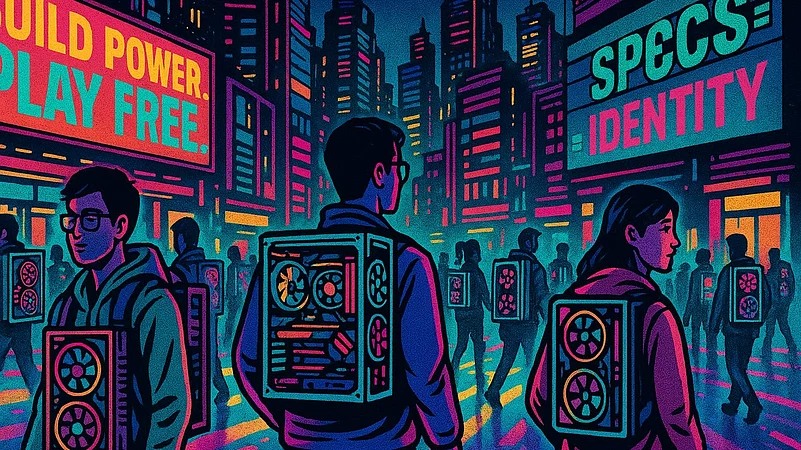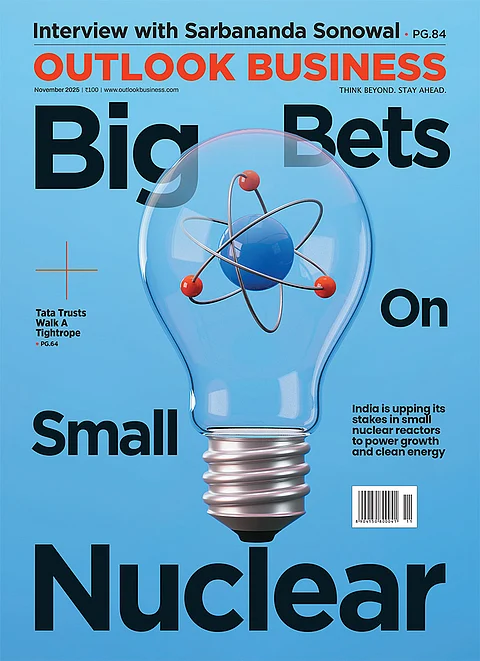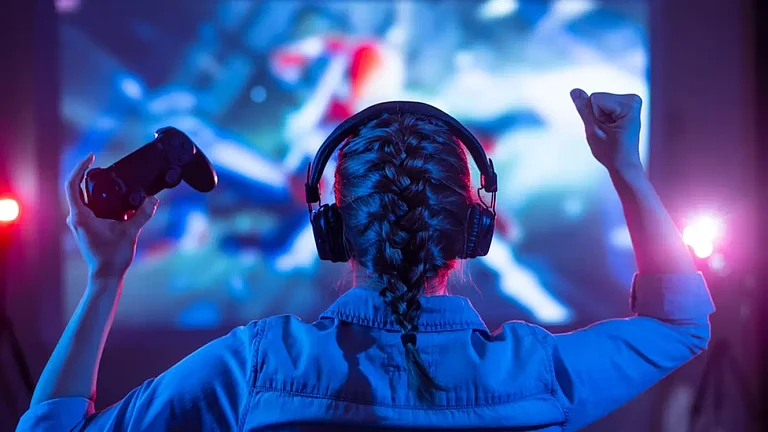Preeth Jwo Martin remembers the moment he realised his laptop couldn’t keep up. “I couldn’t even run the Unreal Engine [game engine] properly,” he said. As a gamer himself, slow renders and choppy previews weren’t just frustrating; they were unsustainable. He needed a machine that wouldn’t throttle under pressure. So, after weeks of research, he purchased a custom PC built to meet his exact needs.
In Bengaluru, another compelling example comes from Colosseum E‑Sports, a packed gaming lounge located near Bamboo Heights. With five to six high-end consoles and PCs, its owner says walk-in gamers, students, working professionals and esports enthusiasts now expect more than a plug-and-play setup. “They want serious power under the hood and no lag whatsoever,” he explains. According to visitors, the place “is always packed”, especially with college students paying around ₹60 per hour. That rising demand has prompted the owner to explore custom PC builds to keep up.
Young gamers are rewriting the rules of performance. No longer satisfied with off-the-shelf machines, they’re piecing together rigs needed to their exact needs from fast frame rates to aesthetic flair. For Raheemudheen, co-founder of AutoCG Studio, an automotive computer-generated imagery company that creates photorealistic 3D visuals of vehicles for marketing and digital media, it started with a single upgrade. “Once I swapped my GPU (graphics processing unit), there was no going back. I realised I could build a system that fit me, not the other way around.”
Preeth, who plays games and streams on the side, echoed that sentiment. “It’s more than gaming now because it’s my workstation, my studio and my console. And yes, I made it from scratch.”
This wave isn’t going unnoticed. “Custom-built PCs are one of our fastest-growing segments, especially among Gen-Z gamers,” says Nvidia. “They’re tech-savvy, design-conscious and very specific about what they want.”
Even hardware retailers see the shift. “Today’s buyers know their specs. They ask for liquid cooling, RAM configurations, even monitor refresh rates,” said Jai Desai, chief executive of EliteHubs, a retailer company of custom gaming PCs and high-end computer parts. “The new gamer isn’t passive, they’re building machines that reflect their identity, whether it's for esports, streaming or content creation.”
Minu Lee, vice president, head of India publishing, Krafton India, also sees a shift beyond mobile. “As young gamers graduate into higher-end experiences, PC gaming becomes a natural progression. India’s next big gaming moment will likely be built on custom rigs.”
According to industry analysts, India’s custom PC segment has grown nearly threefold over the last five years. What began as a corner of enthusiast culture has now become mainstream driven by younger professionals with rising disposable incomes, exposure to global gaming trends and a desire to own performance rigs that reflect their identity.
It is a shift PC builders have witnessed first-hand. “The average order value of a custom PC build has gone up by at least 80% over the last few years,” said Desai. “As new games enter the market and use cases expand, demand has steadily grown especially post-Covid-19.”
For Preeth, the decision to switch was about balancing professional pressure with long-term flexibility. “I couldn’t even run Unreal properly,” he said. Raheemudheen echoed the sentiment: “If you compare price and performance, custom PCs win.” Krafton, known for its hit mobile title Battlegrounds Mobile India (BGMI), sees this evolution as a natural step. “We believe many players who experienced the enjoyment of a AAA-level game [top-tier games developed by major studios with large budgets, extensive marketing and high production values] on mobile were inspired to explore PC gaming in pursuit of an even richer experience,” said Lee.
While creators and professionals form part of the buyer base, it's the gaming community that drives the heart of the trend. Dheeraj Kadpala, a gamer from Hyderabad, recalls playing Forza Horizon on his older laptop, where cars would glitch during turns. “Now, with this rig, it's like the road comes alive. Everything is fluid,” he said.
The Builders Behind the Boom
Preeth built his system himself after researching every component, from graphics processing unit (GPU) benchmarks to cooling requirements. “I did all the selection and building on my own,” he said. Raheemudheen, on the other hand, worked with a custom builder to assemble his professional-grade setup, ensuring it could handle his demanding 3D simulations and rendering workflows.
EliteHubs, which began operations during the pandemic, now caters to a wide audience including gamers, editors, creators and even AI/ML students. But it all started with gamers. “Earlier, gaming used to be seen as a taboo in many households,” said Desai. “Now, parents see custom PCs as multipurpose investments, they’re okay with their children gaming if the same system also supports editing, visual effects or development work.” Gaming continues to be the core motivation for custom builds, with many users later discovering the broader creative and technical possibilities their rigs unlock.
EliteHubs began as a niche store, shipping a few dozen custom PCs monthly. Today, Desai says they handle anywhere from 300 to 400 high-end builds per month.
It’s not just a Mumbai trend either, custom builders across India are seeing similar growth. In Delhi’s Nehru Place, for instance, Gaming PC Wala (Avika Retails) has emerged as a go-to spot for high-performance gaming rigs. Founded in 2012, the store has served over 50,000 customers, ranging from gamers and creators to corporate clients. “We now build and deliver 15-20 custom gaming rigs a month across NCR,” says co‑owner Piyush Tulsian. Their presence reflects across regions showing the rising Indian demand for systems that combine power, aesthetics and reliable service.
Nvidia sees this grassroots PC-building movement as a sign of maturity. “Custom PCs are no longer niche,” they said. “System builders are now trusted advisors who help users align performance with budget.” Through its New Gaming Retail initiative, Nvidia has helped local builders evolve from cramped tech markets into modern retail spaces where users can test-drive systems before buying. Many of these builders now ship across India and even offer Nvidia Studio-certified configurations.
Krafton, while still publishing mobile games in India, is also shaping the PC landscape. Its India Gaming Incubator (KIGI) supports indie developers, most of whom are working on PC-first titles. “We believe this will contribute to the long-term growth of the PC gaming ecosystem,” said Lee.
Specs-wise, Preeth’s machine features an Intel Core i7-12700K processor, an Nvidia Ray Tracing Texel eXtreme (RTX) 4070 Super GPU, 32GB of DDR5 RAM and hybrid storage.
“The 4070 Super struck the right balance between price and performance,” he said. Raheemudheen runs an even more powerful system with a Ryzen 9 9950X, RTX 4080, 64GB RAM and a 1000W power supply unit.
According to industry insiders, the RTX lineup now dominates the Indian market. “A very high percentage of what’s sold in India today are RTX GPUs,” they said. “While gamers were the first to push demand for high-performance builds, we’re now seeing students, developers and creators follow suit, many of whom started building PCs to improve their gaming experience and then realised they could do much more.”
Even when technical terms like “ray tracing” or “DLSS” come up, users are more informed than ever. Ray tracing, for instance, is a rendering technique that simulates realistic lighting and shadows in games, making environments look more cinematic and immersive. Deep learning super sampling (DLSS) uses AI to upscale lower-resolution images, allowing for smoother gameplay without sacrificing visual quality.
Beyond Gaming: Specs, Speed & Serious Upgrades
While custom PCs were once the realm of die-hard gamers, today they’re the default for anyone doing heavy creative or technical work. “I can make changes in real time during client calls,” said Preeth. “I used to wait hours for simulations. "Now it’s seconds or minutes,” said Raheemudheen. Nvidia’s Studio drivers, which come bundled with compatible GPUs, also deliver massive performance boosts in apps like Adobe Creative Suite, sometimes by five times or more.
According to EliteHubs, users are now more technically aware than ever. “Even first-time builders walk in asking about ray tracing, DLSS, airflow, thermals,” said Desai. “They’re watching YouTube, reading forums and they know what they want.” This growing awareness, he says, actually makes it easier for system integrators to explain performance differences and match builds to specific software or game titles. “An Adobe editing rig isn’t the same as one for DaVinci Resolve. We train our sales reps for months so they can guide customers properly.”
And then there’s the aesthetic factor. “People don’t just want fast machines, they want them to look stunning,” said Desai. From glass side panels and RGB-lit fans to futuristic chassis shaped like spaceships, the visual appeal has become a serious consideration. “It’s brag-worthy. When friends come over, your PC is the first thing they notice.”
Nvidia confirms this behaviour. “Buyers are more specs-aware because they’re asking about features, not just frame rates.” EliteHubs adds that while entry-level buyers are still price-sensitive, high-end customers are placing more value on after-sales service. “We offer technical support at home in Mumbai, Pune and Bangalore. That matters when you’re spending over ₹1.5 lakh,” said Desai. “People don’t want to waste weekends going to service centres.”
The shift is reflected in market data too. According to Krafton, India’s gaming PC market was valued at $98mn in 2023 and is expected to grow to $153mn by 2029, with demand for custom builds, high-refresh monitors and GPUs accelerating year on year. “There’s clear growth in engagement for graphics-heavy, complex games,” Lee noted. High-profile streamers showcasing AAA titles are helping fuel the trend. And with games like GTA 6 on the horizon, demand for powerful rigs is expected to spike.
Still, the landscape isn’t without challenges. Hardware costs remain steep especially in India. “A GPU that’s rupees two lakh in the US can be rupees three to four lakh here,” said Raheemudheen. While pricing remains a sticking point, EliteHubs says service standards have improved. “Brands now maintain larger stock buffers, and Tier II cities are seeing better service coverage,” Desai noted. “That’s brought turnaround times down to four to five days for most brands.”
The Custom Future
For creators like Preeth and Raheemudheen, the PC isn’t just a machine; it’s a platform that evolves with their needs. “This setup is my canvas,” said Raheemudheen. “I built what I needed and I don’t regret a thing,” Preeth added.
Nvidia believes the shift is permanent. “Custom PCs are already one of the most important sales channels in India,” they said. Krafton, while still rooted in mobile gaming, sees a powerful future ahead. “India is home to nearly 600mn gamers,” the company noted. “As income levels rise and infrastructure improves, the country is poised to become one of the world’s most important PC gaming markets.”
Desai from EliteHubs agrees but cautiously. “Cloud gaming still has a long way to go in India,” he said. “But hybrid users who like gaming and editing on the same rig are driving the next wave of demand. And they’re only growing.”































